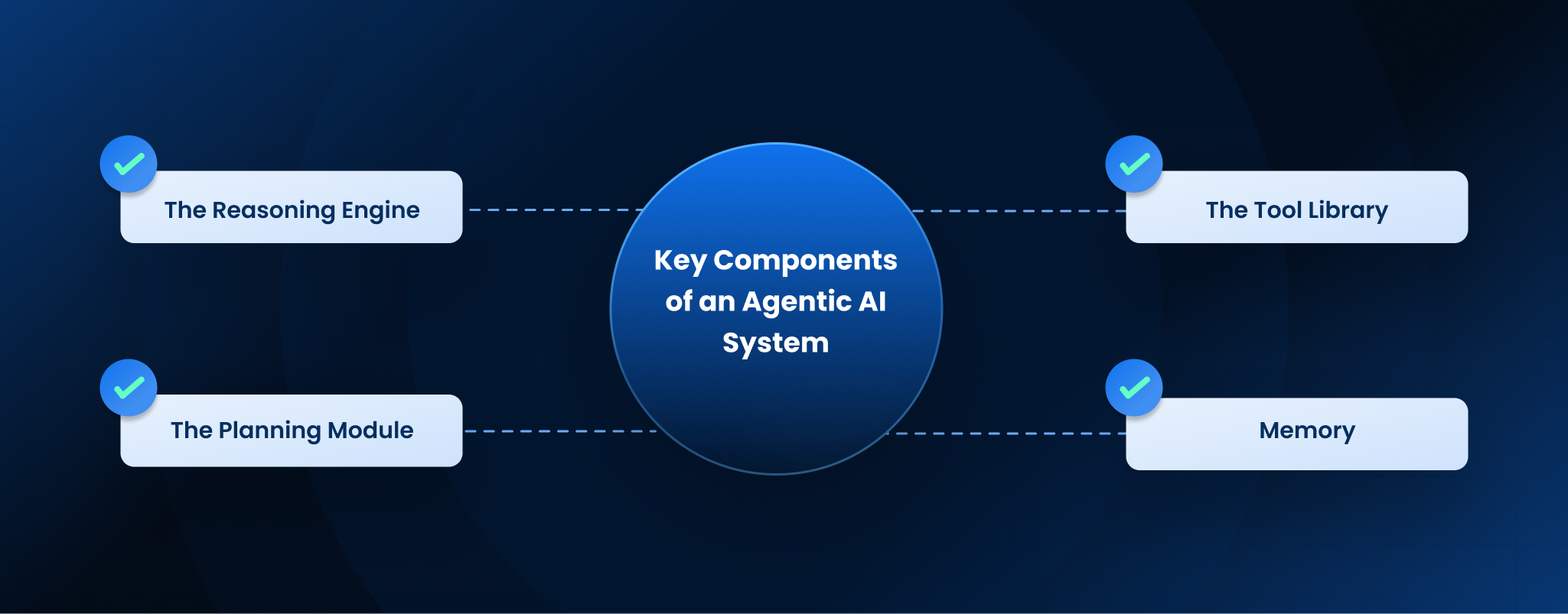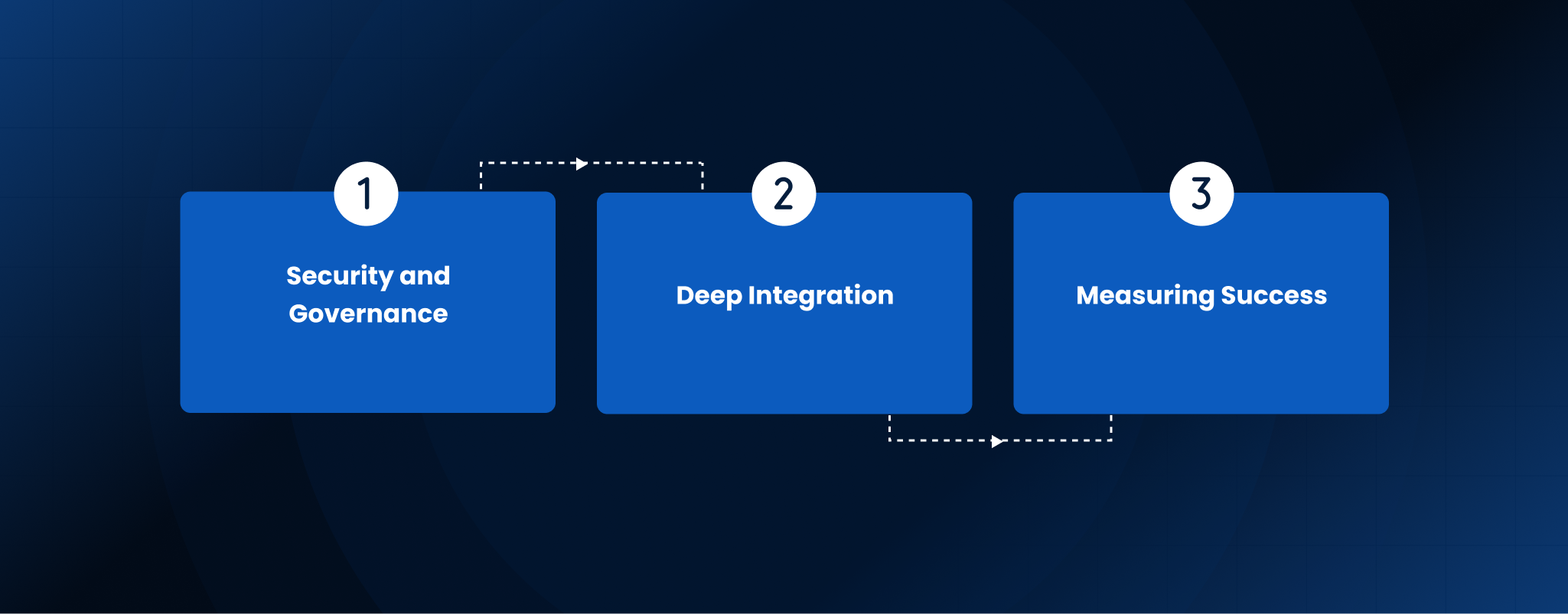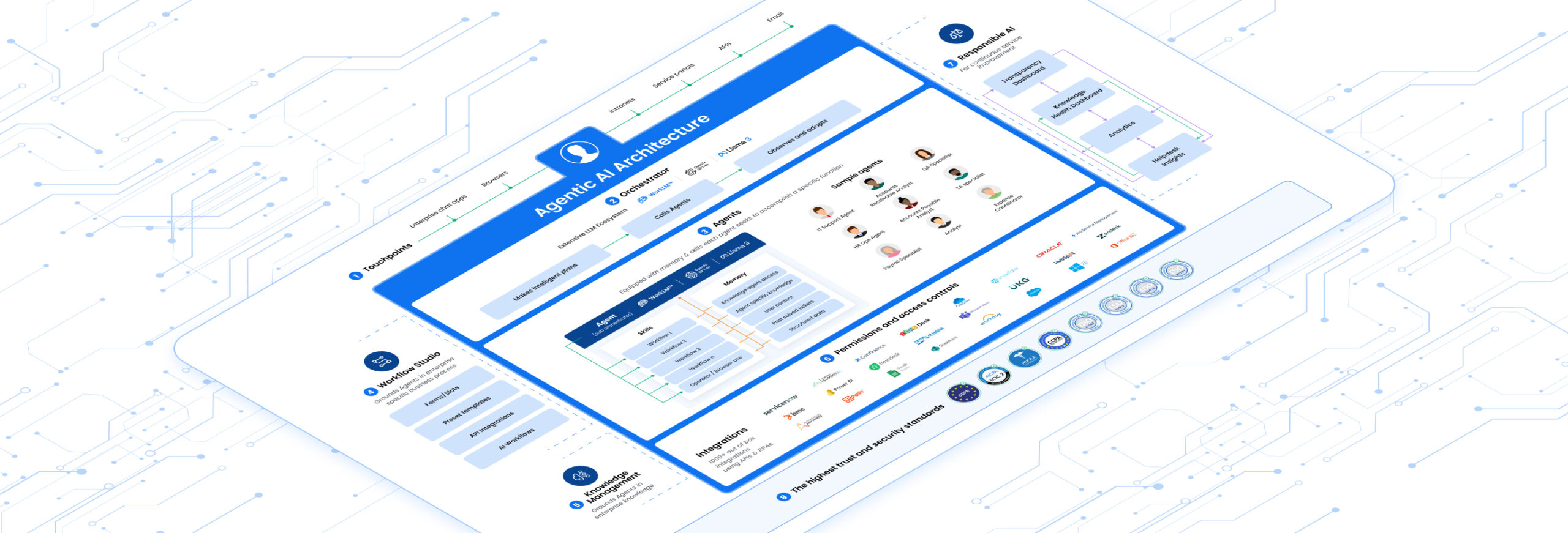Introduction
As a technology leader, you’re likely facing a familiar challenge: employee support requests are growing in volume and complexity, while the pressure to reduce costs and improve the employee experience has never been higher. The traditional model of hiring more support staff or deploying simple chatbots is no longer a sustainable solution. This is where agentic architecture comes in, representing not just an evolution, but a complete paradigm shift in how we approach enterprise automation. Instead of tools that follow rigid scripts, we can now build autonomous agents that think, reason, and act to solve problems on their own.
This guide will walk you through everything you need to know about agentic architecture, from its core principles to its practical applications, and explain why it is the key to unlocking a new level of efficiency and productivity in your organization.
What is Agentic Architecture?
At its core, agentic architecture is a framework for building artificial intelligence systems that can operate autonomously to achieve specific goals. Think of it as the difference between giving someone a detailed, turn-by-turn list of instructions versus just giving them a destination address.
A traditional chatbot follows a script. If a user asks a question, it searches a knowledge base for a matching answer. It’s reactive and limited to its programming. Conversely, an AI system built on agentic architecture is given a goal, for instance, “resolve this employee’s software access issue.” The agent can then independently devise and execute a multi-step plan. This might involve checking the employee’s permissions in one system, verifying their department in another, and finally provisioning access through a third application. It reasons and acts, much like a human would.
Core Principles of Agentic Architecture
To truly grasp the power of this approach, it’s helpful to understand the foundational principles that make an agentic architecture so different. These systems are built to be:
- Goal-Oriented: The agent is driven by the objective, not a predefined workflow. It has the freedom to choose the best path to a resolution, adapting its approach as needed.
- Autonomous: Once given a goal, an agent can operate with minimal human intervention. It can perform tasks, make decisions, and even recover from errors on its own.
- Tool-Using: This is perhaps the most critical principle for enterprise use. Agents can interact with other software and systems. They can use “tools”, like APIs, databases, or command-line interfaces, to gather information and take action in the real world.
- Perceptive and Adaptive: An effective agentic architecture allows the AI to perceive its environment, understand the context of a request, and learn from its interactions to improve its performance over time.
Why Enterprises Need Agentic Architecture
In today’s fast-paced business environment, legacy support models are breaking down. The need for a more intelligent and scalable solution is urgent, and agentic architecture directly addresses the most significant pain points modern enterprises face.
Firstly, it solves the scalability problem. You cannot hire your way out of ever-increasing ticket volumes. An agentic architecture allows you to deploy a digital workforce that can handle an almost unlimited number of requests simultaneously, 24/7.
Secondly, it meets modern employee expectations. Today’s employees are accustomed to the instant, seamless experiences of consumer technology. Consequently, they expect the same level of service at work. Waiting hours or days for a simple IT or HR request to be resolved is a major source of frustration and lost productivity. Agents built on this architecture deliver instant resolutions.
Finally, it tames complexity. Enterprise technology stacks are incredibly complex and interconnected. An agentic architecture is uniquely capable of navigating this complexity, orchestrating actions across multiple applications to resolve issues that would otherwise require the coordinated effort of several human specialists.
Key Components of an Agentic AI System
While the concept can seem complex, an agentic architecture is composed of a few key components working in concert:
- The Reasoning Engine: This is the “brain” of the agent, typically powered by an advanced Large Language Model (LLM). It interprets the user’s goal, reasons about the problem, and formulates a high-level plan.
- The Planning Module: This component breaks the high-level plan down into a sequence of concrete, executable steps. For example, the goal “provision a new software license” becomes a plan: (1) Verify user identity, (2) Check for manager approval, (3) Call the licensing API, (4) Notify the user.
- The Tool Library: This is a curated set of functions and API connections that the agent is permitted to use. This is a critical element for security and control, as it defines exactly what actions the agent can and cannot take within your enterprise systems.
- Memory: Agents possess both short-term memory to manage the context of an ongoing task and long-term memory to learn from past interactions, ensuring they become more effective over time.
Agentic Architecture vs. Traditional AI Models
The distinction between these two approaches is stark. Understanding it is key to appreciating the leap forward that agentic architecture represents.
| Feature | Traditional AI Model (e.g., Chatbot) | Agentic Architecture |
| Operation | Reactive: Responds to specific inputs. | Proactive: Works towards a defined goal. |
| Logic | Scripted: Follows a fixed decision tree. | Reasoning-Based: Devises its own plans. |
| Capability | Single-Task: Performs one action at a time. | Multi-Step Tasks: Orchestrates complex workflows. |
| Action | Information Retrieval: Provides answers. | Autonomous Action: Performs tasks in systems. |
| Human Role | Constant Oversight: Humans must intervene. | Human-in-the-Loop: Humans supervise and approve. |
This evolution from information retrieval to autonomous action is the central value proposition of a well-designed agentic architecture.
Benefits of Adopting Agentic Architecture in Business
Implementing an agentic architecture is not just a technical upgrade; it’s a strategic business decision that delivers tangible returns across the organization.
- Dramatically Reduced Resolution Times: Issues that once took hours or days can be resolved in seconds, as agents work at machine speed.
- Enhanced Employee Experience: Employees get instant, effective support, which eliminates friction and allows them to focus on their actual jobs. This is a significant driver of overall workplace satisfaction.
- Significant Cost Reduction: By automating the end-to-end resolution of a high volume of tickets, you can lower your operational costs and reallocate your support staff to more strategic initiatives.
- Proactive Problem Prevention: Advanced agentic systems can monitor your infrastructure, detect anomalies, and fix potential problems before they impact your employees, moving your support function from reactive to proactive.
- 24/7 Availability and Scalability: Your AI agents never sleep, providing consistent and immediate support across all time zones without the need for additional staffing.
Common Use Cases of Agentic Architecture in Enterprises
The applications of agentic architecture span every support function within an enterprise. Here are a few powerful examples:
- In IT Support: An employee messages, “I can’t access my Salesforce account.” The agent understands the goal, verifies the user’s identity via single sign-on, checks their account status in Salesforce, sees it’s locked due to failed login attempts, unlocks it, and guides the user through a password reset.
- In HR: An employee asks, “How much paid time off do I have left for this year?” The agent securely accesses the HR information system, retrieves the employee’s leave balance, and also checks the holiday calendar to provide a complete, personalized answer.
- In Finance: A manager needs to approve an expense report. The agent can not only notify the manager but also provide a summary of the report, check it against company policy for violations, and allow the manager to approve or deny it directly from their chat window.
Challenges in Implementing Agentic Architecture
Adopting any transformative technology comes with challenges. A successful implementation of agentic architecture requires careful consideration of:
- Security and Governance: Giving an AI system the autonomy to act within your enterprise systems requires robust security measures. This includes strict access controls, secure “tool” management, and comprehensive audit trails.
- Deep Integration: For an agent to be effective, it must connect deeply with your existing systems of record, like ServiceNow, Workday, or SAP. This can be complex, especially with legacy or custom-built applications.
- Measuring Success: The right metrics are crucial. You must move beyond simply counting closed tickets to measuring outcomes like the reduction in ticket creation, improvements in employee productivity, and overall satisfaction scores.
How Leena AI Uses Agentic Architecture to Build AI Agents
Overcoming these challenges is precisely where a specialized platform like Leena AI provides immense value. We have spent years perfecting an enterprise-grade agentic architecture designed specifically for the complexities of the modern workplace. Our AI agents are not generic chatbots; they are purpose-built digital team members.
For example, with Leena AI’s IT Agent, we transform the support experience. When an employee reports a slow laptop, a traditional approach might send them a link to a troubleshooting article. Our agent, built on a powerful agentic architecture, takes autonomous action. It can:
- Diagnose: Securely run diagnostic scripts on the user’s device to check for high CPU usage or low memory.
- Analyze: Cross-reference the findings with a database of common issues.
- Act: Suggest concrete actions, such as closing specific applications or initiating a software update, and perform those actions with the user’s permission.
This is the power of a mature agentic architecture in action. It doesn’t just provide information; it delivers a resolution. It turns your support function from a ticket queue into an instant, autonomous resolution engine, directly improving productivity and the employee experience.
Future of Agentic Architecture in Enterprise AI
We are still in the early stages of what is possible. The future of agentic architecture in the enterprise is incredibly exciting and points toward even greater levels of autonomy.
We will soon see multi-agent systems, or “AI teams,” where specialized agents collaborate to solve highly complex problems. For instance, a “Diagnostics Agent” could identify a network issue and automatically pass its findings to a “Network Agent” to reconfigure a router. Ultimately, this leads to self-healing enterprise systems, environments where an agentic architecture not only resolves issues but also learns from them to prevent future occurrences, creating a truly resilient and efficient organization.
Conclusion
Agentic architecture is more than just the next buzzword; it is the blueprint for the future of enterprise operations. It offers a clear path toward building a truly autonomous, efficient, and responsive organization. By shifting the focus from simply managing tickets to automating outcomes, you can unlock unprecedented value, free up your human experts for strategic work, and provide an employee experience that becomes a true competitive advantage.
Frequently Asked Questions
What is the main difference in an agentic architecture compared to a regular chatbot?
The main difference is the shift from following scripts to achieving goals. A chatbot provides pre-programmed answers, whereas an agentic architecture enables an AI to reason, plan, and take autonomous actions across multiple systems to solve a problem.
How does an agentic architecture ensure security when taking actions?
Security is paramount. A robust agentic architecture enforces strict security through “toolkits” with role-based access controls (RBAC), ensuring agents can only perform authorized actions. It also includes comprehensive audit logs and human-in-the-loop checkpoints for sensitive operations.
Is implementing an agentic architecture difficult for large enterprises?
While building one from scratch is complex, partnering with a platform like Leena AI makes it seamless. We handle the underlying complexity of the agentic architecture, providing pre-built integrations and use cases that allow for rapid and secure deployment.
Can an agentic architecture integrate with our existing systems like ServiceNow or Workday?
Absolutely. Deep integration is a core principle. An effective agentic architecture is designed to connect with the enterprise systems you already use, allowing agents to pull information and push updates to provide end-to-end resolutions.
How do you measure the success of an agentic architecture?
Success is measured by business outcomes. Key metrics include the percentage of tickets resolved autonomously, the reduction in Mean Time to Resolution (MTTR), improvements in Employee Satisfaction (ESAT) scores, and the overall reduction in operational support costs.
Why is agentic architecture becoming so important right now?
The convergence of powerful new language models, the increasing complexity of enterprise IT, and rising employee expectations for instant service has created a perfect storm. Agentic architecture is the first technology that can effectively address all three of these trends at scale.















